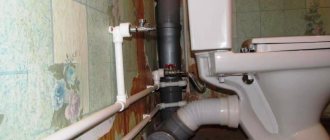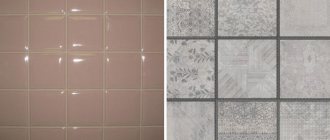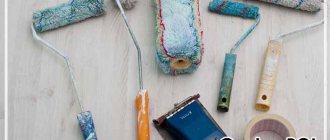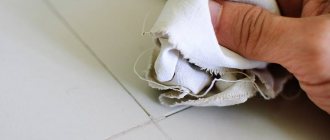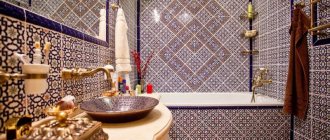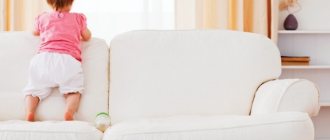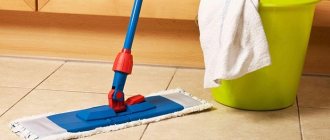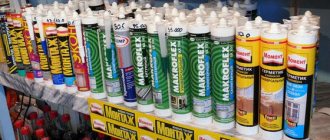Cleaning methods
Each housewife sets her own cleaning schedule. The bathroom is one of the most frequently visited rooms in the apartment, and if you do not distribute cleaning procedures to daily, weekly and monthly, this will complicate the general cleaning of the bathroom, which will be carried out from time to time.
In addition, due to daily water procedures, humid air accumulates in the bathroom, which promotes the proliferation of bacteria, microbes and fungi on all surfaces.
spring-cleaning
If you wipe the walls and plumbing fixtures dry every day after using the sink and shower, then classic general cleaning in the bathroom can be done once a month. You will have to wash the tiles from floor to ceiling, and therefore you need to free up the work space as much as possible.
It is necessary to remove and soak the curtain in a soapy solution, put all the bottles with gels and shampoos, washcloths, brushes and other small items in a separate container, and put the rug in the wash.
Before cleaning the tiles in the bathroom, you should apply detergent compositions to particularly dirty areas and leave for 20-30 minutes to act. Only after this can you begin global cleaning of the bathroom walls, treating tiled areas and other bathroom surfaces with household chemicals.
Quick cleaning
You can quickly wash the tiles in the bathroom after taking a shower. Under the influence of steam, which is formed during the hygienic procedure, dirt and plaque on the tiles become wet, and they can easily be removed with any gentle detergent or even just a soft cloth or sponge. All surfaces should then be wiped dry.
If the surfaces do not become shiny after such quick cleaning, it means that plaque has formed on the ceramic tiles. To get rid of it, you will need special professional or home cleaning products for tiles.
The use of chlorine-containing compounds is allowed. With their help, limescale deposits caused by excessively hard water and rust are quickly removed. In addition, compositions with chlorine are suitable not only for cleaning tiles, but also for antibacterial treatment of surfaces in the bathroom.
Recommendations
A few recommendations to help avoid limescale and stains:
- The ceramic surface can be wiped with a sponge, only with the soft side, do not use an abrasive surface!;
- Use all methods that will allow you to reduce humidity in the bathroom;
- Treat the tiles at least once every 2 weeks with a special product;
- Do not use a wire brush for cleaning;
- You should start washing the tiles from the bottom and rinse off from the top.
If you regularly clean your bathroom, there should be no problems with cleanliness. If such a problem is urgent, you need to choose a cleaning product either from improvised ones or from household chemicals. You can also contact professional cleaning organizations specialized in cleaning.
Article Rating
What can and cannot be used?
The tiles used to decorate walls can be different, but they are always durable and resistant to various types of influences. Many people mistakenly believe that such surfaces will withstand any chemical and mechanical means. However, even the choice of compositions intended for cleaning tiles should be considered carefully.
Most often, people choose finishing materials with a glossy surface. For such a coating, the use of abrasive substances and metal or hard brushes will be detrimental.
These products can quickly clean the tiles in the bathroom, but the small scratches they leave will eventually deprive the tiles of their original shine.
When choosing products for cleaning tiles, you must take into account that the joints between the tiles also require care, but the methods and means of cleaning them must be different. Exposure to acid-containing products will be destructive for building materials used as grout.
It is not recommended to use compositions intended for kitchen or plumbing equipment to clean bathroom tiles from limescale. You should also avoid products containing sand, pumice and fatty components.
After treatment with special cleaning emulsions, the matte tile surface should be coated with wax mastic, which will protect the porous surface from absorbing dirt and also highlight the structure and color of the material.
Careful care of tiles involves using:
- soft sponges;
- wool or felt napkins;
- toothbrushes;
- gentle detergents.
Methods for restoring grout
There are several effective ways to update and lighten seams:
Marker for cleaning tile joints.
- Hardware stores sell products for cleaning bathroom tile joints. Markers and pencils allow you to quickly work on a seam by running the end of the lead along it.
- Paint the seams with waterproof paint or varnish and cover with polish.
- Partially renew the grout. This process is often combined with mold removal.
- If the putty has crumbled, it can be renewed by applying a fresh layer of the same composition. Before repairs, treat the joints with a stiff brush to remove the crumbling layer.
Cleaning Rules
There are several rules for cleaning bathroom tiles from plaque at home. Compliance with them will allow you to achieve a result comparable to what happens after the work of cleaning company specialists using professional bath cleaning products and methods and a steam cleaner for tiles.
To save time and effort during cleaning, you can use the following recommendations:
- Before you start washing the walls, you need to open the hot water tap in the bathroom for a few minutes and close the door tightly. After this steam treatment, the surfaces will be easier to clean.
- You should start cleaning bathroom tiles by washing them with warm soapy water. You can use dishwashing detergent, but not soap, which leaves a difficult-to-remove film on the surface.
- Movements when applying detergent are made from bottom to top, when wiping the tiles dry - from top to bottom.
- If there is severe contamination on the walls, then you can resort to the use of special potent compounds. They should not be applied to large areas at once, because... Dried product is more difficult to wash out.
- We must not forget about health. Rubber gloves and an apron will help protect your skin from aggressive compounds, and a construction respirator will help protect your respiratory system from harmful fumes.
Features of removing stains of different nature
The stains covering the tiles in the bathroom are of different natures, which means they require a different approach when cleaning. All information about pollution and ways to combat it is presented in the table:
| Type of contamination | Reasons for appearance | Means for fighting |
| Limescale | High content of minerals and salts in tap water | Ammonia. Household chemicals. Soda |
| Grout on tiles | Inaccuracy in carrying out repair work | Water. Special softening reagents |
| Rust | Poor quality water | Lemon juice + salt. Vinegar + baking soda. Cream of tartar |
| Mold, fungus | High humidity, poor ventilation | Steam cleaner. “Whiteness”, bleach, special household chemicals. Hydrogen peroxide. Products containing acids |
| Ingrained dirt | Poor maintenance of ceramic tiles | Baking soda, vinegar |
How often to wash?
You need to keep your bathroom clean every day, and not just on those days when you do a general cleaning of the house. To do this, it is enough to spend no more than 10-15 minutes in the bathroom.
After taking a bath or shower, rinse surfaces with clean water and wipe dry to get rid of stains. For regular maintenance of tiled walls, a glass and mirror cleaner is suitable.
Every week you need to pay attention to the seams between the tiles, because... they create a suitable environment for the active proliferation of bacteria. You need to carefully wipe the tile seam from plaque and dirt. You can use bleach and soda for this.
Every month you need to do a thorough cleaning of the bathroom, using as many products as possible. And not only those that can quickly wash bathroom tiles.
Even with daily wiping of surfaces in the bathroom, general cleaning requires a little more diligence. Therefore, you will need deodorizing products to remove odors, disinfectants, and those that can help get rid of old mold in hard-to-reach places that have not previously received enough attention.
Causes of pollution
The main contaminants on bathroom tiles are limescale, soap deposits and mold.
A white or yellowish coating appears after hard water. If it is not removed promptly, it accumulates, forming an unpleasant, rough crust of lime on the surface.
Mold and mildew are even more unpleasant because they not only spoil the appearance of the tiles, but also have a negative impact on your health. They are formed primarily due to irregular and insufficient care. Other reasons for their appearance may be poor ventilation in the bathroom, constant humidity, high temperatures, dirt in the seams between the tiles.
Remove plaque
Daily contact with water leads to the formation of limescale on the surfaces of the bathtub, sink, taps and walls. The water evaporates, and a particle of lime remains in place of the drop.
On the walls, drops of water mix with foamy splashes of soap, shampoo or shower gel. Both soap and limescale deposits should be washed off immediately, because stains that are initially invisible will eventually turn into a thick layer, which will be much more difficult to remove.
To clean limescale from tiles, you can use a special gel, emulsion and factory-made powder, or use improvised means (citric acid, baking soda, etc.).
During cleaning, it should be taken into account that it is impossible to clean the tiles in the bathroom from plaque using folk remedies or store-bought ones in one go. The procedure will have to be repeated several times. And this fact only confirms the importance of preventative daily cleaning.
How to clean kitchen tiles
The main pollutant in the kitchen is grease. During cooking, droplets of fat gradually become more noticeable on the apron and need to be cleaned off. Universal products for various types of tiles: ceramic, earthenware, matte and glossy structures will help you cope with greasy stains on porcelain stoneware:
- Harmless, antibacterial spray Luxus Professional “Clean Bath” (Russia), universal use. It is not capable of damaging the tile surface, adds shine, does not leave streaks, and is easily washed off with water. Removes grease, mold, limescale.
- Mellerud for tiles and stone (Germany). It will quickly dissolve limescale; the product contains phosphoric acid.
- HG for cleaning glossy tiles (Netherlands). The cleaner does not leave streaks and is suitable for glossy and ceramic surfaces.
- Kiilto Clean for tiles (Finland). A product based on oxalic acid removes cement residues, rust and limescale from tiles. Does not damage glossy surfaces.
Luxus Professional “Clean bath”
Mellerud
HG for cleaning glossy tiles
Kiilto Clean
Remove mold
The warm and humid atmosphere of a plumbing room often causes mold to form. Mold must be removed immediately before the spores spread throughout the room. In the bathroom, mold can damage not only the tile seams, but also untiled walls, curtains, pipes, and plastic surfaces.
Mold eats deeply, damages furniture, and gives off an unpleasant odor. In addition, a room contaminated with mold poses a danger to human health.
Chlorine-containing products, copper sulfate, and vinegar will help get rid of black mold stains. Aqueous solutions prepared with these substances should be applied to the surface using a rag or spray bottle and left to act until completely dry. After a few hours, the applied products can be washed off with water and the room dried.
The treatment will have to be carried out several times with a break of 1-2 days. If mold has infected the tile joints, the grout will have to be scraped out and new grout applied after treatment with an antibacterial compound. Each treatment should be carried out in a well-dried and ventilated area.
Preventive measures
Prevention of rapid contamination of bathroom surfaces includes the following actions:
- treatment of grout joints with moisture-proof impregnation;
- daily wipe the surface with a dry cloth to remove fresh stains;
- after cleaning, polish is applied to the tiles to create a protective layer;
- When applying polish, streaks must be avoided; they will be visible after the coating has dried;
- during repair work, the tiles are covered with a protective film;
- After each shower or bath, wipe the tiles with a moisture-absorbing cloth;
- To prevent the formation of condensation, it is recommended to equip the bathroom with a ventilation system.
Cleanliness exists not where people clean, but where they don’t litter. This is one of the rules for keeping premises in order. A similar principle applies to tile maintenance. Regular maintenance cleaning minimizes general cleaning, which uses rather aggressive products.
Cleaning products
To care for a tiled surface, the easiest way is to use ready-made special products that are sold in household chemical stores. They are ready for use and do not need to be diluted or mixed with other substances. However, there are no universal ones among them, so before purchasing you should carefully study their purpose.
A good product must meet the following requirements:
- Be gel-like or liquid. It is better to avoid the use of powders and abrasive pastes, because they spoil the glaze layer, and over time the tile will lose its shine, the gloss layer will be erased irrevocably.
- It is desirable that it contains chlorine. This component makes the product almost universal, because... not only helps to cope with various contaminants, but also destroys bacteria and unpleasant odors.
- Does not contain chalk. Many housewives have long abandoned the use of chalk to clean tiles, because to wipe off the white coating on the tiles will require additional time and effort.
- Does not contain acids. Their impact destroys the layer of putty and grout in the seams.
Features of washing different types of tiles
Glossy tiles
Lime deposits are very noticeable on glossy material. Special preparations can help cope with contamination. You can also treat the surface with water-repellent impregnation.
Matte tile
All stains are clearly visible on the matte surface. A few tips to help you keep your wall coverings perfectly clean:
- After washing, wipe with a dry sponge;
- Add acetic acid during cleaning;
- After cleaning, wipe with glycerin;
- Treat the surface with a steam cleaner.
Relief tiles
Relief tiles are much more difficult to clean, especially if there are old marks. This is why it is so important to carry out general cleaning of the bathroom in a timely manner.
The optimal components for cleaning textured surfaces are special foams that can penetrate deep into the surface.
Floor tiles
Often a matte finish is chosen for the floor because, unlike gloss, it is non-slip. That is why it is necessary to wash it by analogy with matte tiles. It is necessary to take into account the fact that the floor is cleaned much more often. An excellent floor cleaner is acetic acid.
Professional products
When choosing in the store how to clean the tiles in the bathroom from plaque, it is recommended to pay attention to the following household chemical products:
- MULTI FRESH . Produced by the Belgian company Cid Lines. It has a chemically balanced composition that removes most contaminants without streaks.
- CILLIT BANG Universal (purple bottle). Manufacturer: RECKITT BENCKISER. Removes limescale, rust, soap stains and other stubborn stains from various surfaces.
- CILLIT . The white bottle indicates that the product is designed specifically for cleaning surfaces from plaque and rust.
- SANI CLEAN SUPER . Designed for removing lime deposits from acid-resistant surfaces. Before cleaning the tiles in the bathroom, you need to dilute it according to the instructions.
- Sanitol . Manufacturer: GREENFIELD. Removes salt deposits on tiled bathroom walls, instantly dissolves soap stains, and adds shine to the surface.
- Gel SANITA . Russian product produced by the Stupino Chemical Plant. The bottle has an additional mark “Anti-rust”, but the gel effectively removes limescale and gives the surface a shine.
- CHISTIN gel . Another domestic product. Positioned as a sanitary and hygienic product that is used for washing any plumbing equipment, tiles, earthenware.
- Kenolux S100 . The Belgian product contains lactic acid, which can remove any dirt from the surface of the walls. The product is considered safe for seams and putty.
- HELP . Gel-like product for tiles and plumbing. Suitable for full-scale cleaning of plumbing units - cleaning walls, toilets, sinks, taps. Effectively removes water stone and rust. Gives surfaces shine.
- Mr. Proper . The liquid product is considered universal and does an excellent job of removing any old stains on tiles. Does not leave streaks and fills the room with a pleasant aroma.
Household chemicals have a number of advantages. They do an excellent job of destroying bacteria, unpleasant odors, and mineral deposits, but their cost makes us remember that traditional methods also cope with washing tiles just as well.
How to clean tiles? What products can be used to clean tiles?
Every housewife probably knows a lot of ways and secrets of high-quality cleaning of the house; she is able to clean any room: hallway, bathroom, kitchen and others that are so often and heavily soiled. Tile is a covering that can be found in the dining room, bathroom, toilet, and kitchen. Caring for tiles is not difficult; you can easily achieve its shine and perfect whiteness of the “seams” between the tiles using homemade and special chemical products.
So that cleaning tiles does not take a lot of effort and time, it is important to know how to remove various types of contaminants: stains, dirt, whitewash, rust, plaque. In addition to a professional product (you choose it yourself), you should also choose the right cloth (dry or wet, wool or cotton, or a sponge).
IMPORTANT: The biggest problem you may encounter is streaks that remain even after thorough washing. They spoil the entire appearance of the tiles and create a feeling of dirt.
Why does this happen:
- The dirt was not washed out enough. This happens when the tiles were very dirty and washing did not clean them enough. Most often, dust and carbon deposits are smeared (if the tiles are kitchen).
- You washed the tiles not with clean water, but with dirty water. This happens when you try to wash a large area of tile with just one bucket of water. It should be constantly changed; used water contains dirt particles and therefore leaves stains.
- The water you used to wash the tiles is not of high quality. For example, too hard water (which contains a lot of salts) can leave characteristic white stains on the surface of the tile.
- The detergent was not sufficiently removed from the tiles. This indicates that you used too much detergent or did not rinse it well with clean water.
- You washed the tiles with a dirty rag. This happens when you wash tiles and wash them with clean water with the same rag (they need to be changed).
What stains may remain on the tiles:
- Traces of dirt
- Limescale
- Detergent residues
- Scale and traces of fat
IMPORTANT: The effectiveness of cleaning tiles depends on how correctly you choose detergents and carry out the cleaning thoroughly. Only products in an “acidic” environment can remove stains, drips and dirt - they literally corrode stains and leave a glossy shine on the surface.
People resort to “folk” cleaning methods when they do not trust chemicals or are allergic to some of their components. In addition, homemade recipes for cleaning liquids will cost you little and will be completely safe for you and your loved ones (especially children).
What and how to wash tiles?
Folk remedies
You can make your own equally effective tile cleaning products. The components of folk remedies do not act as aggressively on the treated surface as chemical industry products, so removing stains will take longer.
But such compositions do not contain substances hazardous to health and the environment, which allows them to be considered a good alternative to household chemicals for people who suffer from allergies or have small children.
The preparation of any composition requires compliance with proportions. It is more convenient to apply them using a spray bottle.
During work, it is recommended to use gloves and a respirator to avoid skin burns and respiratory tract irritation.
Vinegar
The most common cleaning product among housewives, which can be used for both daily and general cleaning.
Vinegar removes any dirt, incl. calcium deposits and rust, disinfects surfaces. 1 part of the essence is diluted with 10 parts of water, applied to the walls using a spray bottle and left for several minutes. Then rinse off with clean water and wipe the tiles dry with a microfiber cloth.
Table vinegar 6%, diluted in equal proportions with water, can be used daily to prevent the formation of mold fungi.
Soap
Soap is the worst enemy of glossy ceramic tiles. It forms a thin film of fat on the tile, which is not so easy to remove. The fatty base of soap can provoke the appearance of mold fungi, which will be difficult to get rid of.
Instead of soap, it is better to use dishwashing detergent, which perfectly removes grease and dirt. And then apply a composition designed to combat rust, mold or other contaminants.
Soda
Baking soda will help get rid of limescale. It should be used carefully, without using force when applying, because... solid particles may scratch the tile surface. You can soften the powder by bringing it to a paste using a liquid component.
To remove dirt and mold from the seams, use a toothbrush to rub in a paste of baking soda and water. After treatment, just rinse off the applied composition with clean water and wipe the surface dry until shiny.
You can dilute soda powder not only with water, but also with bleach or any bleach.
Another way to use: after applying the soda slurry with a brush, sprinkle with vinegar.
Lemon acid
You can restore the shine to dull tiles and eliminate mold spots using citric acid. Using a damp sponge, rub the dry powder into the contaminated areas, and after 3-5 minutes, wash off with clean water.
An alternative is to wipe the seams and dirty areas with fresh lemon juice (half a fruit).
Ammonia
Pharmacy 10% ammonia solution is ammonia. The product has a characteristic pungent odor, so when working with it you should definitely use a respirator to protect your respiratory tract.
If you dilute 1 tbsp. l. ammonia 1 liter of water, then you can get a universal household cleaner. Experienced housewives use this solution to wash mirrors, windows, and crystal. Ammonia will help and restore the original appearance of the tiles.
You can strengthen the aqueous solution of alcohol with vinegar by adding 1 tbsp. l. The mixture should be sprayed over the surface with a spray bottle, and after 5 minutes, rinse with water. Polish clean tiles with a soft cloth.
A mixture of alcohol and hydrogen peroxide (2:1) can remove traces of rust.
Chlorine
It has a pungent and persistent odor and is irritating to the respiratory system and eyes. But at the same time it is considered the best means for cleaning white tiles and disinfecting the room. Before cleaning mold from colored tiles and grout, the effect of even a weakly concentrated bleach solution should be tested in a place hidden from view.
Dentifrice
All smooth and shiny surfaces can be wiped with a mixture of 2 tbsp. tooth powder and 1 tsp. ammonia.
Borax
Used as a component of many detergents. Effective in deodorizing and disinfecting premises. To clean tiles, borax powder is applied to contaminated areas and tile seams using a damp sponge.
Melamine sponge
The melamine sponge appeared in the arsenal of housewives only a few years ago. The sponge is universal; it can be used to clean different surfaces and stains without using detergents. A dry or moistened sponge works equally effectively, but it should not be soaked in hot water or wrung out with twisting movements.
Fighting limescale using special products
If you are not a big fan of improvised cleaning methods, then you can purchase an effective anti-limescale agent at any household chemical store.
When choosing, you need to remember that abrasive substances are contraindicated for any tile. Acid-based creams and gels, as well as chlorine-containing liquids, are suitable. When choosing, carefully read the composition and method of use. Products with chalk and talc in their composition are not suitable, as they will leave behind a whitish film, which we are trying to avoid. Organic-based chemistry is attractive because it is environmentally friendly, but it is not recommended to use it when cleaning the bathroom: it will become a good environment for the growth of harmful bacteria and fungus.
When working with such household chemicals, follow safety precautions and wear gloves to protect the skin of your hands.
Among the many store-bought tile cleaning products, there are “Cillit”, “Domestos” (liquid formula), “Mr. Muscle”.
How to clean the tiles after completing the renovation?
It is almost impossible to protect walls and floors from splashes, drops, drips, and stains during finishing work. However, you can prepare for subsequent cleaning of the tiles. Moreover, this is not difficult to do, since the building material used during the work is known. For decorative finishing of the bathroom with tiles, use:
- adhesive solution;
- grout;
- primer;
- plaster;
- silicone sealant.
In addition, the tiles may have stains of lime, paint, foam, or traces of construction dust. The simplest algorithm of actions before washing the tiles involves:
- cleaning the walls with a vacuum cleaner from dust and adhering particles of building materials;
- scraping off frozen particles of hard building materials with a small blade or soft spatula;
- washing smeared construction mixtures with special solvents;
- wet treatment of walls with detergents;
- polishing tiles.
Removal products for most construction compounds can be purchased at specialty stores.
Adhesive solution and silicone sealant
Even with the most careful finishing work, excess adhesive will appear in the seams. They must be removed immediately with just a damp cloth and a spatula. If the mixture is dry, then:
- You can wipe off the tile adhesive after it has soaked under a damp cloth. To remove polymer glue, the fabric is moistened with a solution of acetone, ammonia, and vinegar. A solvent will help remove epoxy adhesive stains.
- You can try to remove dirt mechanically. To do this, use sandpaper, a stiff brush, or a scraper. You must act extremely carefully so as not to spoil the glaze layer.
- Porous ceramics will be more difficult to clean because... the compositions eat deeply into the structure of the finishing material. In order to select the right solvent, you should know what kind of glue was used. On the packaging of building materials, manufacturers indicate a solvent suitable for cleaning.
Silicone sealant, used to seal joints (for example, between a bathtub and a wall), protects against moisture and prevents the development of fungus and mold. To ensure accurate application of the sealant, it is recommended to protect the surfaces with masking tape.
This building material firmly adheres to any surface, and it is extremely difficult to remove dried sealant. It will have to be cleaned mechanically (scraper, blade) or chemically (white spirit). Both methods are dangerous for adjacent surfaces; the result can be scratches, chips, areas corroded by chemicals with disruption of structure, color and loss of shine.
Removing primer and cement
These construction mixtures are also easier to clean up right away. This requires no effort, just a wet cloth. If dried stains are found on the tiles after completion of construction work, then the first thing you need to do is try to soften them. Moreover, you can try to moisten the primer stains with fresh primer and then scrape them off with a scraper. For cement, a rag and scraper moistened with hot water will do.
Grout
Most often, the tiles in the bathroom after renovation have to be cleaned of grout. The use of a grout mixture is the final stage of finishing work. Experienced craftsmen seal the joints and remove excess mixture at the same time, while trying not to smear the composition on the tiles, and carefully wipe it with a dry and damp sponge.
Dried grout stains are washed off more easily than an adhesive solution, but the procedure will have to be repeated several times. After the top layer has dried (the seams become lighter), the wall should be moistened with clean water and then rinsed off with another clean sponge.
If epoxy grout was used, then you cannot do without a special solvent.
Cleaning joints between tiles
The tile seams are the most vulnerable spot on a tiled wall. They quickly lose color because... Dirt most often accumulates in them and mold develops. They are also unstable to some cleaning agents. For example, under the influence of hard tools and acidic detergents, the grout mixture may collapse.
The following are considered safe for cleaning seams:
- Steam cleaner. A powerful jet of steam will not only clean any type of dirt, but also get rid of fungal infections. No additional chemicals are required.
- Toothbrush. It is convenient and safe to apply cleaning compounds.
- Gel and liquid bleaches and antiseptics.
If the seams cannot be cleaned or the area of clearance is large, then the easiest way is to replace the grout. To do this, you need to arm yourself with a thin, sharp tool (such as a scraper) to clean out the damaged grout, a new mixture (preferably epoxy) and a rubber spatula. During work, the seams must be soaked with an antiseptic.
Bleaching the seams
Seams that have darkened but remain intact and not affected by mold can be bleached. For work, use household chemicals or improvised products. The most common of them:
- Marker. It is simple to use, but the effect of such an update is short-lived.
- Ready-to-use composition with a whitening component - German Mellerud, Canadian Grout. Both products are designed for cleaning grout, have properties that restore the color of grout, and remove mold and stains.
- A mixture of hydrogen peroxide and baking soda. A paste of these ingredients is rubbed into the seams with a toothbrush and left for 1-2 hours. Then the seams are thoroughly wiped.
Review of chemicals
The stores offer a large selection of household chemicals that will help bring the tiles to a clean and shiny look.
The advantages of using chemicals to clean bathroom tiles include:
- efficiency and instant results;
- ability to get rid of mineral deposits;
- cope with old stains;
- eliminate unpleasant odor;
- have deodorizing properties;
- destroy pathogenic microorganisms.
Chemicals also have disadvantages:
- Many drugs contain alkali. If you use chemicals too often, the tile surface will quickly deteriorate. Abrasive components lead to loss of shine and scratches.
- The compositions negatively affect the grout that is located between the tiles. The color of the putty changes, and over time it begins to crumble.
- People prone to allergic reactions should use caution when cleaning tiles with chemicals.
Work using household chemicals must be carried out in compliance with safety precautions. Before starting work, you need to put on a respirator and household gloves made of rubber or latex. It is advisable to open the window.
"Silit Bang"
The Cillit Bang line of cleaning products includes a composition against plaque and rust, as well as against mold. With Silit Bang, cleaning dirty tiles is easy and quick. To get rid of lime deposits and rust stains, just apply the composition to the contaminated area and leave for 3 minutes. Then all that remains is to rinse off the composition with warm water.
Cillit Bang Anti-Plain + Shine helps get rid of rust, dirty deposits and soap marks in a short period of time. The solution is sprayed onto the damaged areas and left for 4 minutes. At the last stage, all that remains is to rinse off the composition with water.
Silit Bang with chlorine allows you to remove mold from tiles and destroy fungus. The solution is sprayed evenly onto the surface from a distance of 15 cm and left for 16 minutes. Then the surface is wiped with a damp sponge.
See also
25 chemical and folk remedies on how to quickly remove mold from walls in an apartment or house
"Domestos"
Domestos is a universal detergent that not only cleans the surface of dirt, but also destroys harmful microbes, bacteria and fungus:
- The composition is applied to the tiles using a sponge.
- In order for the dirty deposit to soften and be absorbed into the cleaning agent, you need to leave it for 7 minutes.
- Then the composition is washed off with warm water.
To prevent the composition from causing allergies and other reactions on the skin, you need to wear protective gloves when working.
"Mister Muscle"
To keep the tiled wall shiny and streak-free, it is recommended to clean it with the Mister Muscle cleaning product. The product copes well with all types of contaminants, including rust and limescale. The composition fights unpleasant odors and kills germs:
- Spray the spray evenly over the entire dirty surface.
- The components take 6 minutes to act.
- Then the product is washed off with water.
- At the end of the work, wipe the tiles with a dry cloth.
"Comet"
You can wash the tiles using the Comet product. The components of the cleaning base can cope with all types of stains and dirt:
- The composition is sprayed onto the dirty area.
- 9 minutes are enough for the composition to act on dirt.
- In places where there are old stains, wipe with a sponge.
- Then wash off the remaining product with water.
The Comet cleaning product does not contain aggressive components. After cleaning there are no scratches or other damage.
Tile care
There are no housewives who don’t want everything in the bathroom to sparkle, look fresh and comfortable. Moreover, it is not at all necessary to resort to the help of professionals from the cleaning service to restore cleanliness. Achieving sparkling cleanliness in your bathroom and sprucing it up yourself is not so difficult using modern methods and cleaning products.
The main thing is not to wait for the tiles to start attracting attention because they are faded or ready to fall off!
Correcting minor imperfections in a timely manner and maintaining a clear wall cleaning schedule will prevent major problems and keep your bathroom shiny and safe.
How to prevent problems from occurring?
To prevent the destruction of the decorative coating on the walls in the plumbing room, just listen to the advice of professionals:
- Immediately after renovation. Within a few days after installation, a whitish salt coating will appear on the surface of the cladding. This occurs due to the evaporation of moisture. The plaque must be washed off with an acid solution.
- Unglazed tiles should be periodically coated with liquid wax, glossy tiles with vinegar.
- It is also possible to avoid the occurrence of mold fungi. To ensure good ventilation in the room, there must be a ventilation gap of at least 2.5 cm between the door and the threshold.
- After each hygienic procedure, the walls should be wiped dry with a soft cloth. Terry or bamboo towels, microfiber, and suede are suitable for this purpose.
- You can use glass cleaner to make the tiles shine.
- You should familiarize yourself with the purpose and instructions for using the chemical in advance. You cannot use compositions on walls, for example, intended for cleaning toilets.
- The more concentrated the product, the less it should be kept on the surface being treated. When dealing with old plaque, it is better to repeat the procedure several times.
- You should use chlorine-containing cleaning products in the bathroom at least once a week.
But the most important advice: if you learn to pay attention to cleaning the bathroom every day, then general cleaning, which is necessary once a month, will not take more than 30 minutes.
Cleaning bathroom tiles
If there are no old stains or a thick layer of dirt on the tiled floor, you can wash it quickly and easily. In order for the cladding to begin to shine, it is recommended to carry out the cleaning procedure in several stages, which include removing large debris, removing plaque at the joints of tiles, washing floors with water and disinfecting surfaces.
Useful tips
First of all, you need to choose the right basic cleaning product. Ceramics on the floor come in different types, and therefore cleaning compositions must be selected in accordance with its structure. For example, it is better to clean a matte surface with household chemical products from the brands Sif, Mister Muscle or Domestos. They work very effectively and return the tiles to their original appearance in a few minutes.
Glossy cladding should only be washed with a soft cloth and treated with liquid products intended for shiny surfaces. Thick compounds containing abrasive particles are not suitable for this coating, as they will immediately ruin the appearance of the tile.
If during cleaning you cannot completely remove the dirty layer on the floor, it is recommended to close the door to the bathroom and run hot water so that the room is filled with steam. After 15-20 minutes, the plaque will become softer, and getting rid of it will not be difficult.
Joints between tiles must be periodically treated with disinfecting compounds, since mold begins to appear in these places. To prevent the development of fungus, it is necessary to keep the floor dry, avoiding prolonged exposure to moisture on the ceramic surface.
To prevent streaks after cleaning, the tiles should be wiped well. Otherwise, limescale may appear on the surface, which will significantly worsen its appearance.
To preserve the shine of the glossy finish longer, it is recommended to wipe the tiles with a solution of vinegar and water. Matte ceramics are best treated with wax intended for veneering with a velvet surface.
